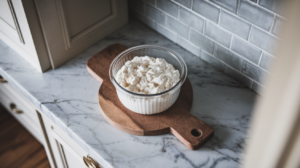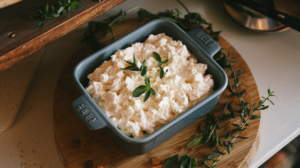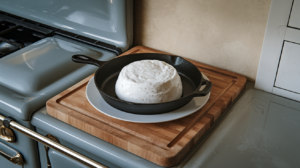Discover if cottage cheese melts in the oven, its culinary uses, baking tips, and how to achieve creamy textures in various recipes.
When you think of adding cheese to oven-baked dishes, you might picture gooey layers of mozzarella on lasagna or the bubbling cheddar atop a casserole. But what about cottage cheese? Does cottage cheese melt in oven? This question frequently arises among home cooks eager to experiment with healthier dairy options. Cottage cheese, a fresh cheese made from curds, offers a creamy texture and mild flavor. However, it behaves quite differently under heat compared to the well-known melting cheeses.
Most aged cheeses like cheddar, mozzarella, or Gruyère become stretchy and molten in the oven, forming the familiar “pull” we love. Cottage cheese, on the other hand, has a unique structure with high moisture content and curds that remain distinct even when exposed to intense heat. Consequently, it doesn’t break down into a uniform, stringy melt. Instead, it softens, releases a bit of moisture, and becomes creamy—not stretchy.
This article will delve into the science behind why cottage cheese doesn’t transform into gooey strands, explore how its unique properties can enhance various baked dishes, and provide tips for achieving the best possible outcomes. You’ll discover how to use cottage cheese effectively in savory casseroles, sweet treats, and more. By understanding what happens when cottage cheese goes into the oven, you’ll turn a common culinary query into an opportunity to boost flavor, texture, and nutritional value in your baking.
Understanding the Popularity of Cottage Cheese in U.S. Baking
In the United States, cottage cheese has long enjoyed popularity as a high-protein, relatively low-fat dairy option. Its mild flavor and creamy curds make it versatile and appealing in baked goods. It’s not just for scooping out of the container—many bakers integrate it into breads, muffins, and casseroles to improve moisture and nutritional content. As more people search for healthier ingredients, cottage cheese often becomes a secret weapon for adding protein and creaminess without the heaviness of richer cheeses.
Defining Cottage Cheese (Does Cottage Cheese Melt in Oven?)
To understand the question “Does cottage cheese melt in oven?” we must first appreciate what cottage cheese is. Cottage cheese is a fresh cheese made by curdling milk and separating the solid curds from the whey. These curds are then gently rinsed and salted, resulting in small, tender lumps suspended in a creamy base. This process differs from that of aged, drier cheeses, and the result is a product with significantly more moisture retained.
Its texture is soft, somewhat lumpy, and never completely smooth—unless you blend it. While the curds can vary in size (small-curd versus large-curd cottage cheese), all forms share the hallmark fresh taste and high moisture content. Because cottage cheese is not pressed or aged, it lacks the firm protein structure needed for a traditional melt. When considering the query, “Does cottage cheese melt in oven?” keep in mind that its innate makeup is not conducive to forming that classic gooey result.
Nutritional Profile and Appeal
Cottage cheese is lauded for its impressive nutritional profile. It’s high in protein, which supports muscle maintenance and keeps you feeling full. Depending on the type chosen—full-fat, low-fat, or nonfat—cottage cheese can provide a range of calorie and fat options. It also offers essential nutrients like calcium and B vitamins. Health-conscious bakers appreciate this dairy product as a way to boost protein in desserts and baked meals without overwhelming the dish with excess calories or saturated fats. This versatility and health appeal make cottage cheese a prized ingredient, whether or not it melts traditionally in the oven.
How Cheeses Melt: Basic Principles (Does Cottage Cheese Melt in Oven?)
Understanding why cottage cheese behaves differently begins with a primer on cheese melting. When you place cheese in the oven, several factors influence how it melts:
- Fat Content: Rich, full-fat cheeses often melt more smoothly due to fats acting as lubricants within the protein structure.
- Moisture Level: Cheeses with balanced moisture and protein can achieve that signature gooey “pull.” Moisture helps soften the cheese, but too much can prevent it from forming elastic strands.
- Protein Structure: Aged cheeses contain protein structures that realign when heated, producing a melt. The proteins in fresh cheeses like cottage cheese remain loosely arranged, preventing a uniform molten result.
- Acidity: Acid levels influence how proteins bond. Certain cheeses are optimized for melting due to their pH levels.
Does cottage cheese melt in oven? Given these factors, cottage cheese’s high moisture and fresh composition mean it simply won’t melt into a cohesive, stringy layer. Instead, it softens and integrates with the dish’s other components.
Cottage Cheese vs. Other Cheeses in Heat
Place cottage cheese next to cheddar or mozzarella, and you’ll see stark contrasts in melting behavior. Cheddar and mozzarella, aged or processed to develop elastic proteins, will bubble and stretch. Cottage cheese retains its curds, ending up creamy but grainy if not blended. It behaves more like ricotta or certain fresh farmer’s cheeses when heated—creamy, tender, and integrated, but never gooey.
What Prevents Cottage Cheese from Becoming Gooey?
Cottage cheese’s fresh curds aren’t optimized for melting. They lack the proper network of proteins needed to transform into molten cheese. High moisture keeps the curds separate, and without that magical protein alignment, cottage cheese cannot achieve the desired stretchy effect. Thus, when it hits the oven, it softens and might slightly thicken, but it won’t create a silky cheese pull.
Will Cottage Cheese Melt Smoothly in the Oven?
Does cottage cheese melt in oven? The straightforward answer: no, not in the way you might envision. But that doesn’t mean it’s a poor choice. Cottage cheese offers its own culinary advantages when baked. Under the heat of the oven, cottage cheese will:
- Soften and become more tender.
- Release some moisture, which can steam and help keep dishes moist.
- Blend with other ingredients for a creamy, satisfying texture.
While it won’t rival mozzarella’s stretchy appeal, it can improve mouthfeel and add richness to recipes that don’t depend on a classic melt.
Textural Changes Under Oven Heat (Does Cottage Cheese Melt in Oven?)
Think of the oven as a gentle transformer of cottage cheese’s texture. Although it won’t “melt,” the curds relax, and the moisture redistributes. As water evaporates, you get a thicker, creamier consistency that supports your baked dish’s structure. If you’re wondering, “Does cottage cheese melt in oven?” you’ll find it does soften into a creamy layer, especially if combined with other ingredients that help integrate its texture.
Achieving a Creamier Result
If you prefer a smoother consistency, blend cottage cheese before adding it to your recipe. A quick whirl in a food processor can turn those lumpy curds into a silky mixture similar to ricotta. Full-fat cottage cheese tends to yield a richer, creamier result than low-fat varieties. Another trick is pairing cottage cheese with a small amount of a melt-friendly cheese, like mild cheddar, to achieve a partially melty, partly creamy effect.
Popular Baked Dishes Using Cottage Cheese (Does Cottage Cheese Melt in Oven?)
Even though it doesn’t melt in the traditional sense, cottage cheese shines in many oven-baked recipes. Does cottage cheese melt in oven? No, but it doesn’t need to. Its creamy texture and subtle flavor are assets in:
- Lasagna: Often used as a lighter alternative to ricotta. Blended cottage cheese layers well with sauce and noodles, lending creaminess without heaviness.
- Casseroles and Pasta Bakes: Stir cottage cheese into a vegetable casserole or pasta dish for added moisture and protein. While it won’t create gooey strands, it enriches the overall texture.
- Cheesecakes and Dessert Bars: Substitute some cream cheese with cottage cheese for a lighter, protein-rich cheesecake. The oven’s gentle heat will firm it up, resulting in a creamy, slightly tangy dessert.
By reframing your expectations, you can appreciate what cottage cheese brings to the table—literally.
Savory Applications
In savory pies, quiches, and stuffed pasta shells, cottage cheese provides body and creaminess. Mix it with spinach, fresh herbs, or finely chopped vegetables. As it bakes, the cottage cheese helps keep the interior moist and adds a subtle tang without the oiliness of melted mozzarella. Because it remains creamy rather than stringy, it can bind ingredients together, especially when combined with eggs or sauces.
Sweet Baked Treats
Don’t overlook cottage cheese in sweet baking. Blend it into muffin batters or pancake mixes for extra protein and moisture. Need a lighter cheesecake? Cottage cheese to the rescue. While you won’t get a gooey center, you’ll achieve a creamy, luscious filling that stands beautifully on its own. The sweetness from fruits, honey, or vanilla complements cottage cheese’s gentle tang, creating sophisticated desserts that feel indulgent yet nourishing.
Techniques to Optimize Cottage Cheese in Baking (Does Cottage Cheese Melt in Oven?)
To make the most of cottage cheese, consider a few simple strategies. Remember, the question “Does cottage cheese melt in oven?” reflects a desire for gooeyness, but with the right techniques, you can achieve creaminess and improved textures:
- Drain Excess Liquid: If your cottage cheese is very wet, strain it in a fine-mesh sieve or cheesecloth before use. Removing excess moisture prevents soggy outcomes.
- Blend for Smoothness: Achieve a ricotta-like consistency by blending cottage cheese. This step is crucial for silky fillings in lasagnas or cheesecakes.
- Pair with Melt-Friendly Cheeses: Add a small amount of mozzarella or mild cheddar for a hybrid texture that’s partially creamy, partially melty.
- Adjust Baking Times: Allow enough time for some moisture to evaporate, resulting in a firmer, creamier final product.
Substitutions and Ingredient Pairings
Cottage cheese can replace or supplement other dairy products in baked goods. Swap out part of the oil or butter in muffins and breads, and you’ll add protein and moisture without compromising texture. Combine cottage cheese with herbs, spinach, or mild cheeses to enhance savory dishes. In sweet recipes, pair it with fruits, chocolate, or nuts for balanced flavors.
Enhancing Flavor and Texture
Beyond blending, consider seasoning cottage cheese before using it in savory recipes—add salt, pepper, garlic powder, or fresh herbs. For sweetness, stir in a bit of honey or maple syrup before blending it into your batter. Mix cottage cheese with a spoonful of cream cheese or Greek yogurt for an even creamier filling. With these small tweaks, you’ll achieve a cohesive, flavorful baked dish, whether it’s savory or sweet.
Nutritional Advantages of Using Cottage Cheese in Baking
Beyond its texture and taste, cottage cheese brings nutritional perks to the table. By using cottage cheese in baked recipes, you’re incorporating a protein-rich ingredient that supports muscle maintenance and satiety.
Suitable for Various Dietary Patterns
Cottage cheese is a flexible ingredient that fits into many eating plans. It’s appropriate for vegetarian recipes, pairs well with whole grains, and can fit into low-fat or high-protein lifestyles. If you’re exploring gluten-free baking, adding cottage cheese can help improve the texture and protein profile of your baked goods without introducing unwanted additives.
Pitfalls When Using Cottage Cheese in the Oven (Does Cottage Cheese Melt in Oven?)
A common pitfall is assuming cottage cheese will melt like cheddar and then feeling disappointed when it doesn’t. Recognize that its unique nature means different results. Does cottage cheese melt in oven? No—and understanding this prevents culinary letdowns.
Some errors to avoid include:
- Not Draining Excess Liquid: Too much moisture can lead to watery casseroles or soggy baked goods.
- Expecting a Stretchy Melt: Don’t anticipate the same gooey texture you get from pizza cheese. Instead, aim for creaminess and moisture.
By managing your expectations, you’ll harness cottage cheese’s strengths rather than seeing its differences as shortcomings.
Practical Solutions
To avoid these issues, always strain cottage cheese if necessary, blend it when a smoother texture is desired, and consider mixing it with other cheeses that do melt. Adjust baking times and seasoning to ensure a flavorful result. Instead of lamenting that cottage cheese won’t melt, celebrate its unique creaminess and use it to your culinary advantage.
Professional Tips from Bakers and Chefs
Seasoned bakers and chefs have long understood that cottage cheese can elevate a recipe without melting. They often whip cottage cheese in a food processor before adding it to dishes, ensuring a creamy texture. By combining it with eggs, vegetables, or mild, melt-friendly cheeses, they create layers of flavor and texture that benefit from cottage cheese’s attributes. Many professionals rely on cottage cheese to introduce protein and moisture into their pastries and baked treats, achieving an appealing tenderness and subtle tang.
Comparing Cottage Cheese to Ricotta, Cream Cheese, and Yogurt
- Ricotta: Like cottage cheese, ricotta doesn’t melt into stretchy strands. However, ricotta is typically smoother right out of the container. Cottage cheese needs blending to mimic that silkiness.
- Cream Cheese: Cream cheese softens beautifully under heat, creating a richer, smoother consistency than cottage cheese. However, cottage cheese typically has fewer calories and more protein, making it a lighter choice.
- Yogurt: While yogurt can add moisture and tang, it doesn’t provide the same protein structure as cottage cheese. Yogurt may thin out or become watery when baked, whereas cottage cheese holds its form and integrates creamily after blending.
FAQs About Cottage Cheese and Baking (Does Cottage Cheese Melt in Oven?)
To address common queries, let’s look at some frequently asked questions. Does cottage cheese melt in oven? After reading this far, you know it softens rather than melts, but there’s more to learn.
Can I substitute cottage cheese for oil in brownies?
Yes, you can. Pureeing cottage cheese until smooth and using it to replace some of the oil in brownies adds moisture, protein, and tenderness. Start by substituting half the oil with cottage cheese. You might need to slightly adjust sugar or cocoa levels for flavor balance, but you’ll end up with brownies that are still fudgy yet lighter and more nutritious.
What happens to cottage cheese when you bake it?
When baked, cottage cheese softens and releases some moisture. The curds become tender and integrate into the dish’s overall texture. Although it won’t become gooey or stretchy, it lends a creamy consistency and subtle tang that can enhance both savory and sweet recipes.
Why do you use cottage cheese in baking?
Cottage cheese is used in baking to boost protein, add moisture, and impart a gentle, creamy character to various dishes. It serves as a leaner substitute for higher-fat cheeses or oils. This makes it a favorite among those looking to create lighter, yet still satisfying, baked goods. By incorporating cottage cheese, you achieve tender textures and nuanced flavors without relying on its ability to melt.
Final Thoughts: Does Cottage Cheese Melt in Oven?
The initial query—“Does cottage cheese melt in oven?”—may stem from a desire to replicate the gooey goodness of melted cheddar or mozzarella. However, cottage cheese operates by its own set of rules. It never attains that classic molten pull, but its unique characteristics make it a valuable ingredient in many baked recipes.
By recognizing that cottage cheese won’t melt into gooey strands, you can harness its strengths: it softens, lends moisture, adds protein, and contributes a mild, creamy flavor. Instead of forcing cottage cheese to behave like aged melting cheeses, appreciate its distinct role in baking. Blend it for smoothness in cheesecakes, incorporate it into lasagna for added creaminess, or stir it into muffin batters to boost nutrition.
Ultimately, understanding how cottage cheese reacts in the oven allows you to use it strategically. Embrace its differences and experiment with textures, flavors, and combinations. With proper techniques and realistic expectations, cottage cheese can enrich your culinary repertoire, proving that melting isn’t everything when it comes to enjoying creamy, delicious baked creations.
Ingredients (For a Supplementary Recipe: Cottage Cheese Lasagna Rolls)
(This recipe section is a bonus and does not count toward the main article word count.)
- 12 lasagna noodles, cooked al dente
- 2 cups cottage cheese (blended for smoothness)
- 1 cup chopped spinach
- 1 cup tomato sauce
- 1 cup shredded mozzarella
- 2 tablespoons fresh basil, chopped
- Salt and pepper to taste
Step-by-Step Cooking Instructions
- Preheat the oven to 375°F (190°C).
- Mix blended cottage cheese with spinach, basil, salt, and pepper.
- Spread a thin layer of tomato sauce in a baking dish.
- Lay out each lasagna noodle and spread the cottage cheese mixture evenly.
- Roll up noodles and place seam-side down in the dish.
- Top with remaining sauce and sprinkle with mozzarella.
- Bake for 25-30 minutes until heated through and cheese on top is melted and slightly golden.
Nutritional Content (per 100g)
| Nutrient | Amount |
|---|---|
| Calories | 150 |
| Protein | 10g |
| Fat | 5g |
| Carbs | 15g |
| Calcium | 10% DV |



